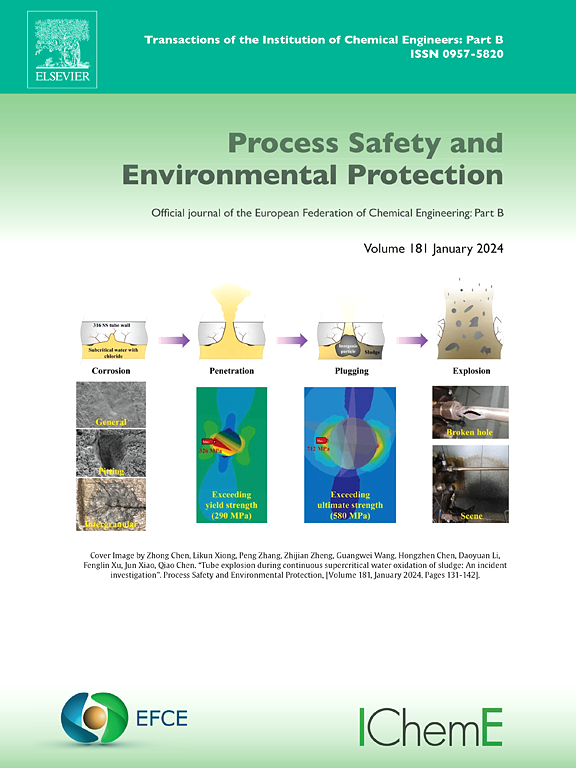ReaxFF MD结合DFT模拟研究PVC与纤维素共热解机理
IF 6.9
2区 环境科学与生态学
Q1 ENGINEERING, CHEMICAL
引用次数: 0
摘要
废塑料和生物质的共热解为可持续和清洁的废物回收提供了广阔的前景。仅仅通过宏观实验来统一聚氯乙烯(PVC)和纤维素(CE)共热解产物的分布和生成机理是一个挑战。本研究通过反应力场分子动力学(ReaxFF MD)结合密度泛函理论(DFT)在分子水平上全面分析了PVC和CE共热解的协同效应机理。PVC为共热解体系提供了充足的·H自由基,促进了生物质降解和含氧基团的脱羧和脱羟基反应。共热解限制了HCl的释放,随着温度的升高,抑制作用逐渐减弱。油和炭的质量随着氧含量的降低而提高。CE单体的脱羟基反应最可能发生在HCl在C4位点的催化下,反应能垒最小为23.87 kJ/mol。·H自由基对糠醛醇化反应有促进作用。在共热解过程中,生物质衍生的活性中间体通过加氢、氧化、捕氢和裂解释放CO2和CO。ReaxFF MD与DFT的结合在微观层面上有效揭示了PVC与CE的共热解机理,为固体废弃物资源化利用产生可再生能源提供了理论补充。本文章由计算机程序翻译,如有差异,请以英文原文为准。
Mechanism research on the co-pyrolysis of PVC and cellulose through ReaxFF MD combined with DFT simulation
Co-pyrolysis of waste plastic and biomass presents great perspectives for sustainable and clean waste recycling. Unifying the distribution and generation mechanism of co-pyrolysis products of polyvinyl chloride (PVC) and cellulose (CE) solely through macroscopic experiments is challenging. In this study, the synergetic effect mechanism of co-pyrolysis of PVC and CE was comprehensively analyzed through reactive force field molecular dynamics (ReaxFF MD) combined with density functional theory (DFT) at the molecular level. PVC provides sufficient ·H radicals for the co-pyrolysis system, which promotes biomass degradation and the decarboxylation and dehydroxylation reactions of oxygen-containing groups. Co-pyrolysis limits the release of HCl, and the inhibition diminishes with increasing temperature. The quality of oil and char improves as their oxygen content declines. The dehydroxylation reaction of the CE monomer is most likely to occur under the catalysis of HCl at the C4 site, accompanied by a minimum reaction energy barrier of 23.87 kJ/mol. The alcoholization of furfural compounds is enhanced by ·H radicals. In co-pyrolysis, the biomass-derived activated intermediates release CO2 and CO through hydrogenation, oxidation, hydrogen capture, and cracking. The conjunction of ReaxFF MD and DFT effectively exposes the co-pyrolysis mechanism of PVC and CE at the microlevel, which provides a theoretical supplement for resource utilization of solid waste to generate renewable energy.
求助全文
通过发布文献求助,成功后即可免费获取论文全文。
去求助
来源期刊

Process Safety and Environmental Protection
环境科学-工程:化工
CiteScore
11.40
自引率
15.40%
发文量
929
审稿时长
8.0 months
期刊介绍:
The Process Safety and Environmental Protection (PSEP) journal is a leading international publication that focuses on the publication of high-quality, original research papers in the field of engineering, specifically those related to the safety of industrial processes and environmental protection. The journal encourages submissions that present new developments in safety and environmental aspects, particularly those that show how research findings can be applied in process engineering design and practice.
PSEP is particularly interested in research that brings fresh perspectives to established engineering principles, identifies unsolved problems, or suggests directions for future research. The journal also values contributions that push the boundaries of traditional engineering and welcomes multidisciplinary papers.
PSEP's articles are abstracted and indexed by a range of databases and services, which helps to ensure that the journal's research is accessible and recognized in the academic and professional communities. These databases include ANTE, Chemical Abstracts, Chemical Hazards in Industry, Current Contents, Elsevier Engineering Information database, Pascal Francis, Web of Science, Scopus, Engineering Information Database EnCompass LIT (Elsevier), and INSPEC. This wide coverage facilitates the dissemination of the journal's content to a global audience interested in process safety and environmental engineering.
 求助内容:
求助内容: 应助结果提醒方式:
应助结果提醒方式:


